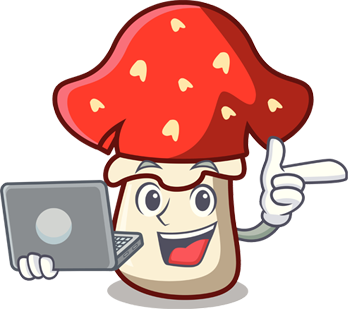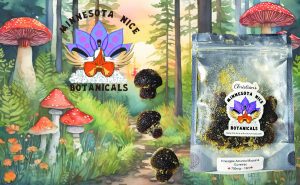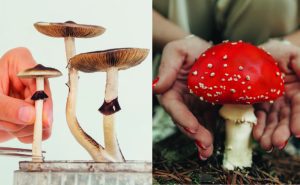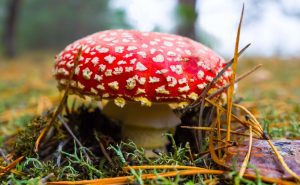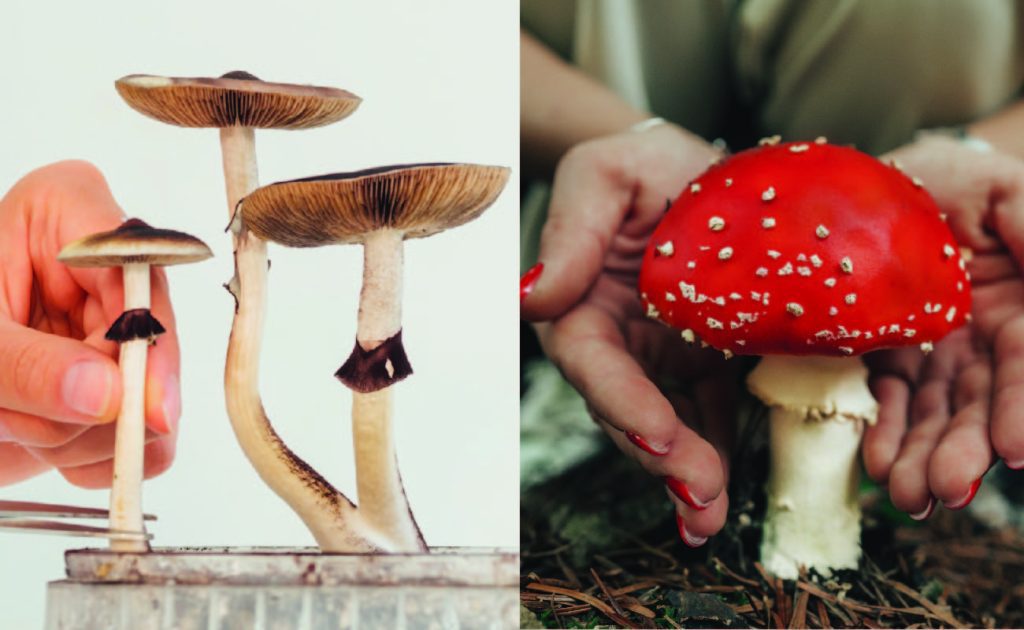
There are two popular types of ‘Magic Mushrooms,’ those that contain muscicmol and those that have psilocybin. This article will summarize muscimol vs psilocybin, their similarities and differences, their effects, and potential benefits.
Psilocybin Mushrooms
Psilocybin mushrooms have caps that vary in size and range in color from light tan to off-white. Their stems are typically white to brown and may have a bluish tinge at times. These mushrooms are popular and commonly used in the U.S. and Europe, which have a rich history in spiritual and religious rituals.
Over 100 species of mushrooms contain psilocybin or its derivative, psilocin [1]. Here are some of the most common mushroom genera that have species of mushrooms that contain psilocybin:
The Psilocybe genus is renowned for its diverse species that produce psilocybin—encompassing over 100 species globally [2]. Notably, Psilocybe semilanceata and Psilocybe cubensis are two of the more well-known species of the genus.
Within the genus Gymnopilus, five species of mushrooms contain psilocybin. Gymnopilus validipes, G. aeruginosus, G. luteus, G. viridans, and G. spectabilis can be considered magic mushrooms [3].
Panaeolus, yet another genus, is known to include species that produce psilocybin. This genus needs to be more thoroughly studied, but so far, at least 20 reported species of Panaeolus that have psilocybin [4].
Finally, the Pluteus genus has several species that contain psilocybin, including Pluteus brunneidiscus, P. salicinus, P. cyanopus, P. glaucus, P. nigroviridis, P. phaeocyanopus, Pluteus villosus, and Pluteus salicinus [5][7]. Pluteus washingtonensis has been listed as having hallucinogenic properties, although psilocybin wasn’t explicitly mentioned in published research [6].
Muscimol Mushrooms
Muscimol is most commonly found in the Amanita genus of mushrooms. Amanita muscaria (fly agaric) and Amanita pantherina contain muscimol, muscarine, and ibotenic acid. These mushrooms are known for their psychoactive properties, and muscimol is one of the psychoactive compounds of Amanita muscaria [8].
Amanita muscaria mushrooms are red with white spots or scales that contain muscimol, ibotenic acid, and muscarine as the main active compounds. These mushrooms can be toxic when eaten raw. In microdoses, they can provide relief from pain, inflammation, anxiety, and sleep issues.
Amanita pantherina, also called the panther cap, has a dark brown to reddish-brown cap with white “scales” resembling a panther’s coat. The mushroom contains toxins like ibotenic acid and muscimol, similar to Amanita muscaria. Amanita pantherina is slightly poisonous and psychoactive, causing dream-like and time-altering effects. It is visually striking but potentially dangerous, especially when consumed raw. Proper identification is crucial to avoid accidental ingestion and associated health risks [9].
The Psychoactive and Psychedelic Compounds
Psilocybin Mushrooms
Mushrooms containing psilocybin, often referred to as magic mushrooms, are classified as a prodrug, meaning they undergo metabolic transformation in the body before becoming active. When individuals consume mushrooms containing psilocybin, the liver metabolizes and converts it into the bioavailable form known as psilocin through a process called dephosphorylation [10]. While both psilocybin and psilocin have psychoactive properties, it is primarily psilocin that induces the psychedelic effects. Similar to LSD, these compounds especially interact with serotonin receptors in the brain, specifically the 5-HT (serotonin) 2A subtype receptors, resulting in the creation of an altered sensory experience [11]. Psilocybin activates serotonin receptors across the brain’s significant networks, leading to information processing in novel ways. While on psilocybin, previously unconnected parts of the brain communicate, leading to alterations in normal functions such as fear response, mood, cognition, and perception [12].
Apart from psilocybin and psilocin, these mushrooms can contain hundreds of other active compounds contributing to these fungi’s full range of effects [13]. Here are a few intriguing ones:
- Baeocystin: A precursor and analog of psilocybin, found as a minor active compound.
- Norbaecystin: An analog of psilocybin and a minor active compound (alkaloid).
- Aeruginascin: An active metabolite of aeruginascin, a naturally occurring tryptamine. It shares chemical similarities with psilocybin and psilocin.
- Harmine: A beta-carboline alkaloid with diverse psychopharmacological effects.
- 4-hydroxy-N, N-trimethyltryptamine (4-HO-TMT): The presumed active metabolite of aeruginascin, a naturally occurring tryptamine in “magic mushrooms.” This compound closely resembles bufotenine, the N-trimethyl analog of serotonin naturally found in toad venom.
- Norpsilocin: A derivative of psilocybin, exhibiting greater potency than psilocin when acting on 5-HT2A receptors.
Muscimol Mushrooms
Amanita mushrooms do not contain psilocybin but are considered by many to be magic mushrooms. Instead, the primary active compounds found in these mushrooms are muscimol, ibotenic acid, and muscarine [14]. Muscimol and ibotenic acid are responsible for the psychoactive effects of Amanita muscaria. Muscimol activates GABA neurotransmitters, primarily affecting the body’s nervous system [15].
- Muscimol acts as a potent central nervous system depressant, engaging GABAa receptors to induce sedative-hypnotic, depressant, and hallucinogenic effects [16]. It is ten times more robust than ibotenic acid in strength.
- Ibotenic acid interacts with glutamate receptors, stimulating heightened and increased energy [17]. When mushrooms have higher levels of ibotenic acid compared to muscimol, users often experience a combination of confusion, agitation, and euphoria.
- Muscarine is present in small amounts (0.02% dry weight) and is considered the least potent psychoactive compound in this particular species. Despite its relatively low potency, this minor alkaloid affects muscarinic acetylcholine receptors in the parasympathetic nervous system, leading to noticeable physiological responses such as increased salivation and sweating. Furthermore, muscarine is associated with various other bodily functions, including sexual arousal, crying, urination, digestion, and defecation [18].
Muscimol vs Psilocybin | The psychedelic and psychoactive effects
Psilocybin mushrooms induce profound psychedelic effects, whereas Muscimol mushrooms tend to elicit more psychoactive effects, with higher doses resulting in subtle psychedelic experiences. The distinction between psychedelic and psychoactive effects lies in their respective mechanisms of action and the subjective experiences they produce.
Psilocybin, a classic psychedelic compound, interacts with serotonin receptors in the brain, leading to profound perceptual alterations, emotional shifts, and transformative spiritual experiences [11]. This process facilitates the development of new neural connections, known as neuroplasticity, empowering individuals to reshape their lives and cultivate lasting transformations. The effects of psychedelics encompass a wide range of experiences. For instance, species like Psilocybe cubensis can induce sensory enhancement, visual hallucinations, and profound spiritual insights at higher doses [19].
- Enhanced creativity, where ideas flow more freely, and innovative thoughts come to mind.
- Geometric patterns emerge when the eyes are closed, creating intricate and mesmerizing shapes.
- Mild to intense visuals like glowing and shimmering, sometimes with a halo effect.
- Vivid colors that appear more vibrant and intense, with tracers or trails of light following moving objects.
- Spiritual insights and a deeper connection to one’s inner self or a higher power.
- A sense of the world “breathing,” as if the environment is expanding and contracting.
- Distorted vision, where the perception of shapes and sizes may be altered or warped.
These experiences can vary in intensity during altered states induced by meditation, psychedelic substances, or certain spiritual practices.
The psychedelic effects of psilocybin mushrooms typically manifest within 30 to 60 minutes of consumption, reaching their peak after 1-2 hours and subsiding after about 4-6 hours. Following the experience, individuals may sometimes experience an “afterglow” period that lasts from several hours to several days.
The psychoactive effects of muscimol vs psilocybin differ significantly. When consumed, Amanita muscaria often induces a profound slumber accompanied by vivid visions and deep insights that frequently manifest in dreams. Some individuals compare these effects to the intoxication experienced from alcohol. This activation can lead to calmness, sedation, euphoria, and dream-like experiences. Depending on the dosage, muscimol can cause subtle shifts in perception, drowsiness, uplifting effects, vivid dreams, and hallucinations [20].
The psychoactive symptoms of Amanita muscaria include:
- Euphoria is a blissful trance where a sense of immense joy and contentment envelops the mind, creating a heightened sense of happiness and well-being.
- Physical relaxation or a tranquilizing effect allows the body to unwind and release tension, resulting in a deeply calming and soothing experience.
- Sedative effects induce a state of calmness and tranquility, allowing for a peaceful and restful experience
- Dream-like sensations transport the individual to a surreal and otherworldly realm, where imagination and reality intertwine, offering a unique and enchanting journey.
- Diminished motor skills, as the body’s coordination and physical abilities may be slightly impaired, contributing to a feeling of lightness and relaxation.
- Impaired vision, where the perception of the surroundings becomes altered and distorted, adds an element of intrigue and mystique to the experience.
- Very high doses give hallucinatory experiences where the boundaries of reality blur, leading to vivid and immersive visions that can be awe-inspiring and mind-expanding.
Symptoms typically manifest between 30 to 90 minutes post-consumption, with peak intensity occurring approximately 2 to 3 hours later.
Legal or Not? Muscimol vs Psilocybin
Psilocybin Legal Status
States such as Colorado and Oregon have recently made significant strides by decriminalizing or legalizing psilocybin mushrooms. However, it’s important to note that at the federal level in the U.S., they are still classified as Schedule I controlled substances, thus remaining illegal.
Despite this classification, there have been promising developments. The Food and Drug Administration authorized some meticulously controlled human studies to explore the potential use of psilocybin in medical and psychiatric settings. The FDA has even recognized psilocybin as a “breakthrough therapy” for depression, which may fast-track the development of psilocybin-based treatments for those with treatment-resistant depression.
Muscimol Legal Status
Contrarily, Amanita muscaria mushrooms are legal in most jurisdictions. The active compounds they possess are mainly unregulated and do not feature on the DEA’s controlled substance list, thus rendering A. muscaria federally lawful in the United States.
While the FDA has not approved Amanita muscaria mushrooms for human consumption, the sale of Amanita products is allowed in every state except Louisiana. Several brands have emerged, legally offering non-psychoactive A. muscaria extracts online for personal use.
Psilocybin Therapeutic Value
Since the 1960s, extensive research has been conducted on psilocybin, unveiling its potential in treating various disorders. Within therapeutic environments, psilocybin mushrooms have demonstrated efficacy in addressing conditions like OCD, headaches, anxiety, depression, post-traumatic stress disorder, and addiction. These findings highlight the promising role of psilocybin in the realm of medicinal treatments. Both types of magic mushrooms increase serotonin and dopamine levels [21][2].
Muscimol Therapeutic Value
For centuries, tribal groups in Scandinavia, Eastern Europe, and Russia have relied on the medicinal properties of Amanita muscaria, commonly known as fly agaric mushrooms. These mushrooms were treasured for their analgesic, anti-inflammatory, anxiolytic, and stimulant effects. Recent research on the pharmacology of this mushroom further validates its traditional uses, highlighting the potential medicinal benefits of muscimol found in Amanita muscaria. These benefits include stress and anxiety relief, muscular pain alleviation, promoting restorative sleep, and exhibiting anti-tumor and memory-protecting activities [16].
Muscimol vs psilocybin mushrooms is two substances that have been used for centuries by cultures worldwide. Both substances are used for their psychoactive effects, but they offer distinct experiences. Muscimol is known for its sedative effects and is often described as producing a dream-like state, while psilocybin mushrooms are known for their more intense visual and emotional experiences. Research is ongoing to understand these substances’ full potential, such as medicinal and therapeutic purposes.
Resources
[1] Analysis of Psilocybin-Assisted Therapy in Medicine: A Narrative Review
Alexander Muacevic and John R Adler
https://www.ncbi.nlm.nih.gov/pmc/articles/PMC8901083/
[2] The Therapeutic Potential of Psilocybin
Henry Lowe, Ngeh Toyang, Blair Steele, Henkel Valentine, Justin Grant, Amza Ali, Wilfred Ngwa and Lorenzo Gordon
https://www.ncbi.nlm.nih.gov/pmc/articles/PMC8156539/
[3] The occurrence of psilocybin in Gymnopilus species
G M Hatfield, L J Valdes
https://pubmed.ncbi.nlm.nih.gov/565861/
[4] Global species diversity and distribution of the psychedelic fungal genus Panaeolus
Dominique Strauss, Soumya Ghosh, Zurika Murray, and Marieka Gryzenhout∗
https://www.ncbi.nlm.nih.gov/pmc/articles/PMC10238702/
[5] Detection of Psilocybin and Psilocin in Norwegian Species of Pluteus and Conocybe
A. L. Christiansen, K. E. Rasmussen, K. Høiland
https://www.thieme-connect.com/products/ejournals/abstract/10.1055/s-2007-969726
[6] Fungifama The Newsletter of the South Vancouver Island Mycological Society August 2006
http://www.svims.ca/ff0608.pdf
[7] A Worldwide Geographical Distribution of the Nerotropical Fungi, an Analysis and Discussion
G. Guzmán, J. W. Allen & J. Gartz
http://www.museocivico.rovereto.tn.it/UploadDocs/104_art09-Guzman%20&%20C.pdf
[8] Muscimol, a psychoactive constituent of Amanita muscaria, as a medicinal chemical model structure
P Krogsgaard-Larsen, L Brehm, and K Schaumburg
http://actachemscand.org/pdf/acta_vol_35b_p0311-0324.pdf
[9] Analysis of hallucinogenic constituents in Amanita mushrooms circulated in Japan
Kenji Tsujikawa, Hiroyuki Mohri, Kenji Kuwayama, Hajime Miyaguchi, Yuko Iwata, Akinaga Gohda, Sunao Fukushima, Hiroyuki Inoue, Tohru Kishi
https://www.sciencedirect.com/science/article/abs/pii/S0379073806000090
[10] Metabolism of psilocybin and psilocin: clinical and forensic toxicological relevance
Ricardo Jorge Dinis-Oliveira
https://www.tandfonline.com/doi/abs/10.1080/03602532.2016.1278228
[11] Psychedelic effects of psilocybin correlate with serotonin 2A receptor occupancy and plasma psilocin levels
Martin K. Madsen, Patrick M. Fisher, Daniel Burmester, Agnete Dyssegaard, Dea S. Stenbæk, Sara Kristiansen, Sys S. Johansen, Sczabolz Lehel, Kristian Linnet, Claus Svarer, David Erritzoe, Brice Ozenne & Gitte M. Knudsen
https://www.nature.com/articles/s41386-019-0324-9
[12] Increased global integration in the brain after psilocybin therapy for depression
Richard E. Daws, Christopher Timmermann, Bruna Giribaldi, James D. Sexton, Matthew B. Wall, David Erritzoe, Leor Roseman, David Nutt & Robin Carhart-Harris
https://www.nature.com/articles/s41591-022-01744-z
[13] Synthesis and Biological Evaluation of Tryptamines Found in Hallucinogenic Mushrooms: Norbaeocystin, Baeocystin, Norpsilocin, and Aeruginascin
Alexander M. Sherwood, Adam L. Halberstadt, Adam K. Klein, John D. McCorvy, Kristi W. Kaylo, Robert B. Kargbo, and Poncho Meisenheimer
https://pubs.acs.org/doi/abs/10.1021/acs.jnatprod.9b01061
[14] Amanita muscaria: Ecology, Chemistry, Myths
Quentin Carboué and Michel Lopez
https://www.mdpi.com/2673-8392/1/3/69
[15] Extrasynaptic δ‐GABAA receptors are high‐affinity muscimol receptors
Ali Y. Benkherouf, Kaisa‐Riitta Taina, Pratap Meera, Asko J. Aalto, Xiang‐Guo Li, Sanna L. Soini, Martin Wallner, Mikko Uusi‐Oukaricorresponding
https://www.ncbi.nlm.nih.gov/pmc/articles/PMC6438731/
[16] Muscimol as a treatment for nerve injury-related neuropathic pain: a systematic review and meta-analysis of preclinical studies
Hamzah Adel Ramawad, Parsa Paridari, Sajjad Jabermoradi, Pantea Gharin, Amirmohammad Toloui, Saeed Safari, Mahmoud Yousefifard
https://www.epain.org/journal/view.html?doi=10.3344/kjp.23161
[17] Ibotenic Acid Biosynthesis in the Fly Agaric Is Initiated by Glutamate Hydroxylation
Dr. Sebastian Obermaier and Prof. Dr. Michael Müllercorresponding
https://www.ncbi.nlm.nih.gov/pmc/articles/PMC7383597/
[18] Muscarine Compound Summary
https://pubchem.ncbi.nlm.nih.gov/compound/9308
[19] Acute, subacute and long-term subjective effects of psilocybin in healthy humans: a pooled analysis of experimental studies
Erich Studerus, Michael Kometer, Felix Hasler, Franz X Vollenweider
https://journals.sagepub.com/doi/abs/10.1177/0269881110382466
[20] Reasons, Form of Ingestion and Side Effects Associated with Consumption of Amanita muscaria
Michal Ordak, Aleksandra Galazka, Tadeusz Nasierowski, Elzbieta Muszynska and Magdalena Bujalska-Zadrozny
https://www.mdpi.com/2305-6304/11/4/383
[21] Monoamines in the brain under the influence of muscimol and ibotenic acid, two psychoactive principles of amanita muscaria
P. König-Bersin, P. G. Waser, H. Langemann & W. Lichtensteiger
https://link.springer.com/article/10.1007/bf00402378
Jessica Reinhart
Jessica is a gifted and passionate writer with a wealth of experience contributing to a variety of websites from news and informational sites to medical clinics sites and every site in between. She is particularly devoted to writing about the cannabis and psychedelic industries. When she isn't busy tapping away on her keyboard, you can find her taking long hikes and spending time with her pets.
